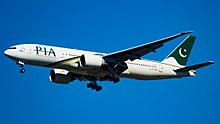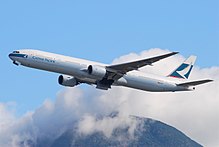777-200[edit]

777-200 N7771 in Boeing's original livery with its firm customers' tail logos beneath the windows
The initial 777-200 made its maiden flight on June 12, 1994 and was first delivered to United Airlines on May 15, 1995.[78] With a 545,000 lb (247,200 kg) MTOW and 77,000 lbf (340 kN) engines, it has a range of 5,240 nautical miles (9,700 km) with 305 passengers in three-class.[158] The -200 was aimed at U.S. domestic airlines.[21] Nine different -200 customers have taken delivery of 88 aircraft,[1] with 55 in airline service as of July 2018.[12] The competing Airbus is the A330-300.[159]
777-200ER[edit]

A 777-200ER of British Airways, its launch operator
The B-market 777-200ER ("ER" for Extended Range), originally known as the 777-200IGW (increased gross weight), has additional fuel capacity and an increased MTOW for transatlantic routes.[77] With a 658,000 lb (298.46 t) MTOW and 93,700 lbf (417 kN) engines, it has a 7,065 nmi (13,084 km) range.[160]It was delivered first to British Airways on February 6, 1997.[78] Thirty-three customers received 422 deliveries, with no unfilled orders as of February 2018.[1]
As of July 2018, 338 examples of the -200ER are in airline service.[12] It competed with the A340-300.[161] Boeing proposes the 787-10 to replace it.[162] The value of a new -200ER rose from $110 million at service entry to $130 million in 2007; a 2007 model 777 was selling for $30 million ten years later, while the oldest ones had a value around $5–6 million, depending on the remaining engine time.[163]
It could be delivered de-rated with reduced engine thrust for shorter routes to lower the MTOW, reduce purchase price and landing fees(as 777-200 specifications) but can be re-rated to full standard.[164] Singapore Airlines ordered over half of its -200ERs de-rated.[164][165]
A British Airways 777-200ER flew the fastest New York to London subsonic flight at 5 hours and 16 minutes in January 2015 due to strong tail winds.[166][167][a][168][importance?]
777-200LR[edit]

A Boeing 777-200LR in the colors of its first operator, Pakistan International Airlines
The 777-200LR ("LR" for Longer Range), the C-market model, entered service in 2006 as one of the longest-range commercial airliners.[169][170] Boeing named it Worldliner as it can connect almost any two airports in the world,[10] although it is subject to ETOPS restrictions.[171] It holds the world record for the longest nonstop flight by a commercial airliner.[10] It has a maximum design range of 8,555 nautical miles (15,844 km) as of 2017.[160] The -200LR was intended for ultra long-haul routes such as Los Angeles to Singapore.[84]
Developed alongside the -300ER, the -200LR features an increased MTOW and three optional auxiliary fuel tanks in the rear cargo hold.[169] Other new features include extended raked wingtips, redesigned main landing gear, and additional structural strengthening.[169] As with the -300ER and 777F, the -200LR is equipped with wingtip extensions of 12.8 ft (3.90 m).[169] The -200LR is powered by GE90-110B1 or GE90-115B turbofans.[172] The first -200LR was delivered to Pakistan International Airlines on February 26, 2006.[95][173] Eleven different -200LR customers took delivery of 59 aircraft, with no unfilled orders.[1] Airlines operated 50 of the -200LR variant as of July 2018.[12] Delta Air Lines and Emirates are the largest operators of the LR variant, each operating 10 aircraft.[174] The closest competing aircraft from Airbus are the discontinued A340-500HGW[169] and the A350-900ULR.[175]
777-300[edit]

A 777-300 of Cathay Pacific, its launch operator
Launched at the Paris Air Show on June 26, 1995, its major assembly started in March 1997 and its body was joined on July 21, it was rolled-out on September 8 and made its first flight on October 16. The 777 was designed to be stretched by 20%: 60 extra seats to almost 370 in tri-class, 75 more to 451 in two classes, or up to 550 in all-economy like the 747SR short-range variant. The 33 ft (10.1 m) stretch is done with 17 ft (5.3 m) in ten frames forward and 16 ft (4.8 m) in nine frames aft for a 242 ft (73.8 m) length, 11 ft (3.4 m) longer than the 747-400. It uses the -200IGW 45,200 US gal (171,200 L) fuel capacity and 84,000–98,000 lbf (374–436 kN) engines with a 580,000 to 661,000 lb (263.3 to 299.6 t) MTOW.[176]
It has ground maneuvering cameras for taxiing and a tailskid to rotate, while the proposed 716,000 lb (324.6 t) MTOW -300X will need a semi-levered main gear. Its overwing fuselage section 44 was strengthened, with its skin thickness going from the -200's 6.3 to 11.4 mm (0.25 to 0.45 in), and received a new evacuation door pair. Its operating empty weight with Rolls-Royce engines in typical tri-class layout is 343,300 lb (155.72 t) compared to 307,300 lb (139.38 t) for a similarly configured -200. Boeing wanted to deliver 170 -300s by 2006 and to produce 28 per year by 2002, to replace Boeing 747 Classics, burning one-third less fuel with 40% lower maintenance costs.[176]
With a 660,000 lb (299,370 kg) MTOW and 90,000 lbf (400 kN) engines, it has a range of 6,005 nautical miles (11,121 km) with 368 passengers in three-class.[158] Eight different customers have taken delivery of 60 aircraft of the variant,[1] with 48 in airline service as of July 2018.[12] The last -300 was delivered in 2006 while the longer-range -300ER started deliveries in 2004.[1]
777-300ER[edit]

A 777-300ER in livery of Air France, its launch operator
The 777-300ER ("ER" for Extended Range) is the B-market version of the -300. Its higher MTOW and increased fuel capacity permits a maximum range of 7,370 nautical miles (13,650 km) with 396 passengers in a two-class seating arrangement.[160] The 777-300ER features raked and extended wingtips, a strengthened fuselage and wings and a modified main landing gear.[177] Its wings have an aspect ratio of 9.0.[178] It is powered by the GE90-115B turbofan, the world's most powerful jet engine with a maximum thrust of 115,300 lbf (513 kN).[179] Following flight testing, aerodynamic refinements have reduced fuel burn by an additional 1.4%.[92][180] At Mach 0.839 (495 kn; 916 km/h), FL300, -59 °C and at a 513,400 lb (232.9 t) weight, it burns 17,300 lb (7.8 t) of fuel per hour, its operating empty weightis 371,600 lb (168.6 t).[181]
Since its launch, the -300ER has been a primary driver of the twinjet's sales past the rival A330/340 series.[11] Its direct competitors have included the Airbus A340-600 and the A350-1000.[105] Using two engines produces a typical operating cost advantage of around 8–9% for the -300ER over the A340-600.[182] Several airlines have acquired the -300ER as a 747-400 replacement amid rising fuel prices given its 20% fuel burn advantage.[93] The -300ER has an operating cost of $44 per seat hour, compared to an Airbus A380's roughly $50 per seat hour (hourly cost is about $26,000), and $90 per seat hour for a Boeing 747-400 as of November 2015.[183]
The first -300ER was delivered to Air France on April 29, 2004.[184] The -300ER is the best-selling 777 variant, having surpassed the -200ER in orders in 2010 and deliveries in 2013.[1] As of July 2018, 784 Boeing 777-300ER aircraft were in service.[12] As of December 2018, -300ER deliveries to 45 different customers totalled 799, with 45 unfilled orders.[1] At its peak, a new 777-300ER was valued $170 million, falling to $150 million in 2019.[185]
In July 2018, Boeing was studying a 777-300ER freighter conversion, targeted for the volumetric market instead of the density market served by the 777F. After having considered a -200ER P2F program, Boeing hopes to conclude its study by fall as the 777X replacing aging -300ERs from 2020 will generate feedstock.[186] New-build 777-300ER freighters may maintain the delivery rate at five per month, to bridge the production gap until the 777X is delivered.